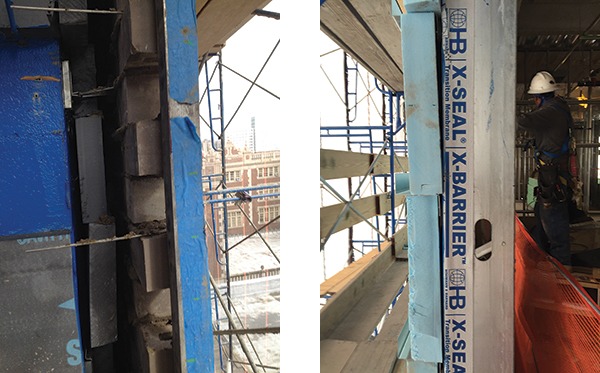Mason contractors across the country face similar challenges when out in the field. With the help of Hohmann and Barnard’s director of technical services, Jeremy Douglas, Masonry delivers answers to some of your most technical, complicated questions.
 Jeremy Douglas
Jeremy Douglas
Q. I’ve always stuck rigid insulation board directly against a fluid-applied air barrier material while it’s still wet, so it sticks to the backup wall. I have a job where I’ve been told I can’t do that, but instead I have to use a special clip that slides over the anchor to hold the insulation in place. Wouldn’t it be better to adhere the insulation directly to the wall?
A. Believe it or not, I’m asked this question almost every day due to the multitude of anchoring systems we see on our projects, and the need for maintaining energy performance. Let’s look at this from various perspectives.
First, whether adhered or using an anchor clip, it is imperative that the insulation remain tight to the backup wall in order to maintain its intended R-value. It is suggested that a loosely laid extruded polystyrene insulation can lose between 15 and 20 percent of its R-value if an air gap of even 1/4–3/8 inch is left. With energy code requirements demanding higher performance from our walls, the requirement of a mechanical attachment or retaining clip is becoming more prevalent.

Many anchors hold the insulation on their own or will have a retaining device, such as a large-diameter washer, integrated into the anchor itself. Other systems that don’t have this integrated piece can use a secondary retaining clip to secure the insulation prior to the brick installation, ensuring the insulation is and remains tight to the backup wall. This can be particularly useful on hook-and-eye-style anchorage systems, where even though the hook portion of the system may retain part of the insulation, construction tolerances may not keep it set tightly.
This leads us more directly to your question about adhering the insulation, or, more specifically, adhering the insulation directly to a still-wet application of a fluid-applied air barrier system. While this has been done with some regularity in the past, it is not a great idea. Just like various types of insulation, an air barrier system can only guarantee a particular performance criteria at a specific thickness. If we are embedding a sheet of insulation into an uncured fluid-applied membrane, that required thickness will likely become depleted, and therefore the system becomes non-uniform in its rate of vapor permeance. Additionally, varied thickness of the membrane will likely diminish its ability to elongate during movement or span various small cracks or voids as we depend on it to do. will also likely create curing issues with many types of air barriers, as they depend on air exposure for that process to advance.
This does not mean that adhesion of the insulation to the barrier isn’t possible, but it means we may need to reconsider how we achieve that. First, before we go about adhering the insulation panels, the air barrier must be fully cured. From here, we might employ a thin bead of a construction adhesive or sealant confirmed to be compatible with both the air barrier system and the insulation. This material must be free of any solvents in order to work with most air barriers used today. In many cases, a sealant or filler accessory for the air barrier system is a good product to look at first, as they are usually fairly inert and unlikely to cause damage to the insulation. But, as mentioned, confirm adhesion strength as well as compatibility.
Ultimately, the important thing is that the insulation panels are retained tightly to the backup wall. How that happens is really subject to field conditions and specified anchors, though we must always maintain the integrity of all adjacent systems, especially the air barrier.
Jeremy Douglas, CSI, CCPR, has nearly 20 years of experience in the masonry industry working with veneer systems. He is director of architectural services for Hohmann & Barnard and can be reached at JeremyD@h-b.com.
